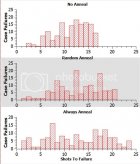prone.life
Silver $$ Contributor
Interesting analysis of brass work hardening by Alpha Munitions (Brass, Reamers, etc). They track brass hardness through seven firings of their 308 offering. Eight minute fun watch.
Yea, ideally your dies minimally work the brass but enough to yield the brass.Just to clarify.
My idea of annealing just after the first firing is the most work/hardening on the brass is done in the first firing, then the amount work/hardening drops down a bunch for each firing.
Certainly virgin brass almost for sure won't fit the chamber as well as fired and resized.One thing mentioned is if a shooter wants to bring brass back to "virgin" each firing, ostensibly because virgin brass shot the best, then annealing must be done each firing. I'm curious if annealing brings brass back to "virgin", or just to the same hardness as virgin. My experience is the first, virgin seating is very different than subsequent seating's when annealing every time.
Yes, annealing can bring brass back to "virgin" softness, but gotta keep in mind the whole cycle of movement the brass is going through from firing to after sizing.One thing mentioned is if a shooter wants to bring brass back to "virgin" each firing, ostensibly because virgin brass shot the best, then annealing must be done each firing. I'm curious if annealing brings brass back to "virgin", or just to the same hardness as virgin. My experience is the first, virgin seating is very different than subsequent seating's when annealing every time.

As I've always pointed out, the big issues about annealing vs not annealing is how much is the brass being worked during the cycle of firing and sizing. If a chamber and sizing die are customized to where there's very little movement going on during this cycle, then one can do just fine without any annealing and the data from that Alpha test video supports that hypothesis. But if one has a mass produced factory chamber and likewise a sizing die where there's a lot of movement going on, then annealing can really be a benefit. Then, you have everything in-between.By their data, I would believe load development should be done after 2nd firing of brass(if not annealing). And if you anneal after the first firing, load development and subsequent loads need annealed brass to keep the tune. For consistency.
Cannot believe they bought that hardness tester. Big bucks!Interesting analysis of brass work hardening by Alpha Munitions (Brass, Reamers, etc). They track brass hardness through seven firings of their 308 offering. Eight minute fun watch.
Kajun, no.One factor they didn't/ cant test. Brass age or precipitation hardens too. think about old ammo that get split necks in storage, thats what thats from.
Thanks Lee. Do you anneal? Do you keep your brass in the same cycle?For SR Benchrest, shooting 6ppc, her are my thoughts on this subject.
First, what is considered as Brass Failure in the charts above?
Other than loose primer pockets, I don’t know why I switch out my brass. I don’t observe performance changes. Example, at last year’s IBS group Nationals, I believe I finished 8th in the UNL 200 yards event using brass that had been loaded 20-25 times. I would have a hard time proving to myself that I would have won shooting newer brass.

